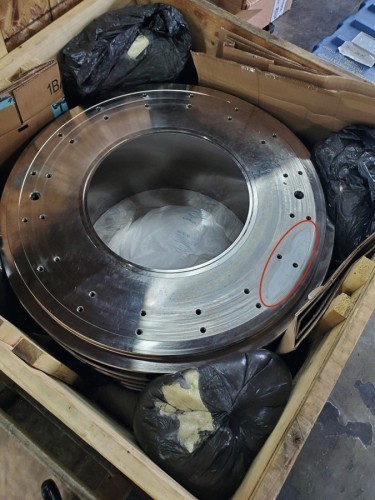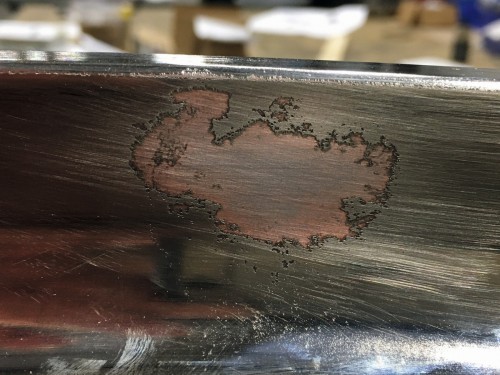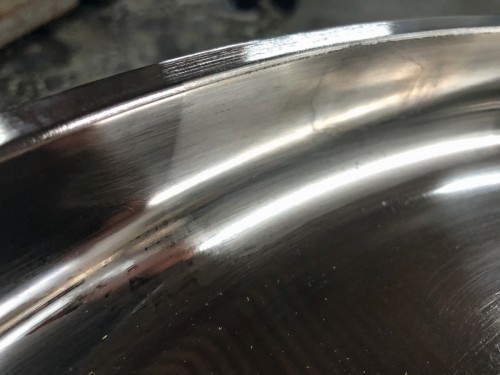There are many applications with electroless nickel. But what happens when parts need to be repaired or reworked? As a rule, they are then either scrapped and replaced or, if possible, dismantled and rebuilt. A quick and comparatively inexpensive alternative is selective coating.
Surface coatings made of nickel and nickel alloys are used in many branches of industry and form a resistant surface with good wear and corrosion protection properties. This makes these coatings indispensable for critical applications - especially where harsh conditions prevail, such as in the aerospace, marine, petrochemical and oil and gas industries. Nickel-phosphorus alloys in particular are increasingly being used due to their unique physical and chemical properties.
Coating with nickel-phosphorus alloys can be done electrolytically. However, due to their unique ability to provide a uniform coating for complex geometries, they are often applied by an electroless, autocatalytic process. However, this technique, known as electroless plating, also has some disadvantages. This is the case when parts coated with electroless nickel phosphorus (ENP) need to be repaired or replaced.
To explain: as ENP coating takes place in a bath, recoating areas that have already been coated can result in the part being out of tolerance due to excessive material build-up. To avoid this, either extensive - and often costly - masking must be carried out, or the entire part must be chemically decoated before recoating.
However, there is an alternative to the processes mentioned above - selective electroplating or coating. This process focuses only on limited, specific surfaces of a part and not on the entire geometry, so that the question of uniformity of the coating across different geometries no longer plays a role. When it comes to the repair, refurbishment and remanufacturing of ENP-coated parts, the selective coating process therefore offers a solution that can save a lot of time and money. Components that should normally be scrapped can be salvaged without compromising the quality or integrity of the part.
The traditional ENP repair
Repairing damaged ENP components often requires chemical stripping of the entire component, which can come with a significant risk of irreparable damage to the part. Although masking is possible, it can be complex and time-consuming. The situation is similar in the manufacture of original parts, where incorrect machining after coating can impair quality and lead to rejects. Similarly, even minor damage, such as small scratches during transportation, can lead to the part being rejected.
While sending components back for electroless nickel plating is an option, it involves more time, cost and risk. The SIFCO process from the US company SIFCO Applied Surface Concepts (SIFCO ASC) from Independance, USA, can be an alternative.
The advantage of the selective method
 The defect is marked on the machine part coated with electroless nickelWithselective coating, the key word is "selective". A nickel coating that reflects the performance characteristics of ENP can be applied precisely to small and clearly defined areas - without the need to immerse the part in a coating bath. This eliminates the need to replace the entire part or dismantle components. Equally advantageous is that the coating system can be brought to the part in question and the repair carried out on the spot.
The defect is marked on the machine part coated with electroless nickelWithselective coating, the key word is "selective". A nickel coating that reflects the performance characteristics of ENP can be applied precisely to small and clearly defined areas - without the need to immerse the part in a coating bath. This eliminates the need to replace the entire part or dismantle components. Equally advantageous is that the coating system can be brought to the part in question and the repair carried out on the spot.
How does selective plating work and how effective is it?
Selective electroplating is a long-established technology that was originally developed in 1938. Today, the SIFCO selective plating process is approved for use in numerous industries, including military, aerospace and energy.
Selective electroplating involves passing an electrical circuit that is closed when an anode touches the component to be coated. This allows the coating to reach the negatively charged part. The entire process takes place without the part having to be immersed in a conventional electroplating bath. The coating can be applied precisely and reliably to specific areas without the need for post-processing. Deposition rates are also up to 60 times faster than tank plating, further minimizing downtime.
Mobile coating also for aluminum
Although the process can be automated, selective electroplating is a manual process that requires minimal equipment - typically a portable rectifier that can be easily transported to facilitate on-site touch-ups.
Aside from portability and the ability to repair only certain areas, the quality of the coating is comparable to tank plating in terms of performance, hardness and adhesion. Just like traditional tank coating methods, selective coating forms a metallurgical bond with the base material. The selective coating process can also provide good results on aluminum substrates that require ENP refreshing, for example.
An electrolytic nickel-phosphorus option for selective repair
SIFCO ASC uses a specially developed coating - 5709 nickel-phosphorus. It is the same alloy used in electroless nickel plating. 5709 Nickel-Phosphorus allows the coater to adjust the coating parameters so that the phosphorus content varies depending on the application. This means that a single coating solution can be used to apply coatings with both low and high phosphorus content - depending on the desired surface properties. With a high phosphorus content, the structure of the coating changes from crystalline to amorphous, which results in good corrosion resistance.
The process also consumes less energy and produces less waste water than tank coating, which has environmental benefits.
The process can also be automated to ensure consistent application for repeated applications in both pre-treatment and coating. Data logging and traceability is also possible.
Photos: SIFCO ASC




